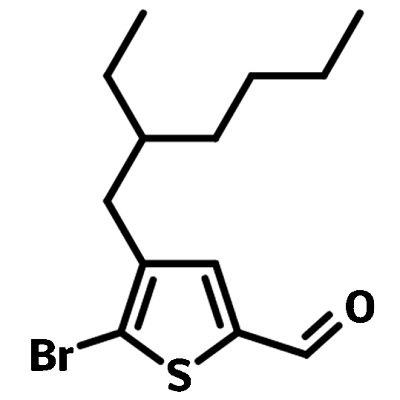EHThCHO-Br
CAS Number 1356861-54-5
Carbaldehyde Monomers, Chemistry Building Blocks, Heterocyclic Building Blocks, Materials, MonomersEHThCHO-Br, for the synthesis of low band gap non-fullerene acceptors
High purity monomer available online for fast, secure dispatch
Specifications | MSDS | Literature and Reviews
5-Bromo-4-(2-ethylhexyl)-2-thiophenecarboxaldehyde (EHThCHO-Br), CAS number 1356861-54-5, is the intermediate that is used for the synthesis of low band-gap non-fullerene acceptors (NFAs). Semiconducting materials bearing 5-bromo-4-(2-ethylhexyl)-2-thiophenecarboxaldehyde such as IEIC and IEIC-4F exhibit good thermal stability, strong absorption in the 500–750 nm region with great extinction coefficients.
Ternary non-fullerene polymer solar cell based on PBDB-T:ITCN:IT-M mixture gained a power conversion efficiency of 12.16% with increased short-circuit current density (Jsc) and open-circuit voltage (Voc) comparing PBDB-T:ITM-based device.
Functional thiophene derivative
Synthsis of semiconducting materials
High purity
>98% EHThCHO-Br Purity
Worldwide shipping
Quick and reliable shipping
Ethylhexyloxyl group
enhances solubility and lowers the bandgap
General Information
| CAS Number | 1356861-54-5 |
| Chemical Formula | C13H19BrOS |
| Molecular Weight | 303.26 g/mol |
| Synonyms | 5-Bromo-4-(2-ethylhexyl)-2-thiophenecarboxaldehyde |
| Classification / Family | Thiophene derivatives, Organic semiconducting materials, Semiconductor Synthesis, Low band gap polymers, OFETs, OLED, Organic Photovoltaics, None-fullerene acceptors (NFAs), NFA-OSCs |
Chemical Structure

Product Details
| Purity | >98% |
| Melting Point | N/A |
| Appearance | Brown liquid |
MSDS Documentation
Literature and Reviews
- High-performance fullerene-free polymer solar cells with 6.31% efficiency, Y. Lin etal., Energy Environ. Sci.,8, 610-616 (2015); DOI:10.1039/C4EE03424D.
- Ternary Nonfullerene Polymer Solar Cells with 12.16% Efficiency by Introducing One Acceptor with Cascading Energy Level and Complementary Absorption. W. Jiang et al., Adv Mater., 30(1), (2018); doi: 10.1002/adma.201703005.

 EHThCHO-Br MSDS Sheet
EHThCHO-Br MSDS Sheet